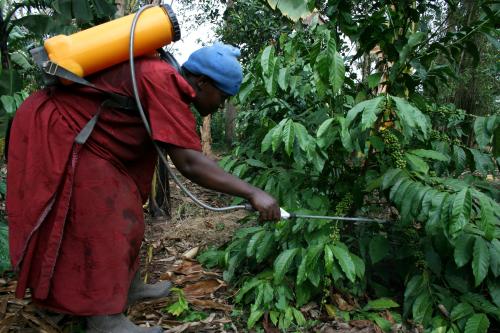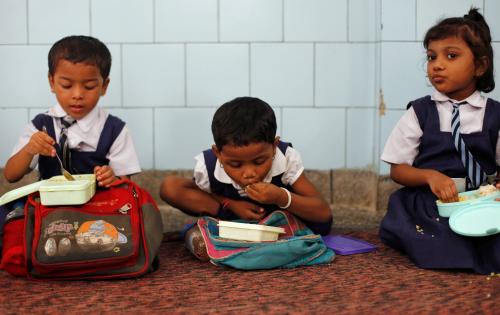Content from the Brookings Institution India Center is now archived. After seven years of an impactful partnership, as of September 11, 2020, Brookings India is now the Centre for Social and Economic Progress, an independent public policy institution based in India.
India faces an invisible public health crisis in the form of widespread maternal and child undernutrition. One-third of Indian women (of reproductive age) are undernourished, and close to 60 million children (under five years of age) are at risk, that is, they are either stunted (low height-for-age) or wasted (low weight-for-height). Women and adolescent girls face the added burden of societal discrimination, which manifests in their unequal access to food, healthcare and resources. As a result, about 42% of Indian women are underweight when they begin pregnancy—compared to about 15% in African countries.
Like mother, like child: A child raised in India is far more likely to be malnourished than one from the Democratic Republic of Congo, Zimbabwe, or Somalia. India’s failure to feed its young results from its inability to address the multiple contributing factors of undernutrition, and to prioritize early life-cycle investments. Given that 50% of the growth failure in the first two years of age occurs in the womb owing to poor maternal nutrition, policy must target the first 1,000 days of a child’s life (from conception to the two-year post-natal period).
The lack of nutrition is not only a denial of a fundamental human right, it is also poor economics. Undernutrition has adverse, irreversible consequences for a child’s cognitive and physical development. Field studies reaffirm the link between the provision of school meals and improved learning outcomes for children, including better classroom concentration. Undernutrition also remains one of the leading causes of child mortality: Close to 70% of children between the age of six months and five years in India suffer from anaemia, which, if left untreated, increases susceptibility to illness, raising morbidity.
The poor state of maternal and child is accentuated by stark state-level disparities in nutritional status. Take the case of stunting in children under 5: rates range from 50% in Uttar Pradesh to 19% in Kerala. State-level disparities are likely to be aggravated further with the budgetary realignments after the 14th Finance Commission. According to the Centre for Policy Research’s Accountability Initiative, Central allocations to the Integrated Child Development Services (ICDS) declined almost 10%, from Rs15,502 crore in 2015-16 to Rs14,000 crore in 2016-17. Not all states have been able to plug the funding gap.
Policymakers can break the tenacious hold of hidden hunger by being sensitive to three key facts. First, early life-cycle interventions targeting the first 1,000 days of a child’s life are crucial for reducing a child’s susceptibility to infections, and breaking the link between undernutrition, disease and mortality.
Second, direct nutrition interventions can reduce stunting only by 20%; indirect interventions, for example, access to water, sanitation and hygiene, must tackle the remaining 80%. The Swachh Bharat Abhiyan should be used to leverage policy complementarities with household sanitation, and behavioural change encouraged through social messaging, and information-education-communication activities for pregnant and lactating mothers.
Third, policy must deliver universal, rights-based nutrition services, which overcome disparities across gender, communities and geographical regions. Take the current situation of the ICDS supplementary nutrition programme: Food reaches barely 20% of children in Uttar Pradesh, but over 90% of children in Odisha.
India’s ability to harness long-term demographic dividends rests on it prioritizing nutrition in its health agenda, and reforming the institutional framework through which interventions are delivered. Most importantly, to combine fragmented efforts, a nodal government body should be established with responsibility for meeting time-bound nutrition targets, and coordinating multi-sectoral programmes, including the ICDS, the National Rural Health Mission, the midday meal scheme, and the public distribution system.
Simultaneously, the ICDS should be restructured to improve targeting and strengthen last-mile delivery. Reforms include standardizing the nutritional component of supplementary food, prioritizing educational outreach, and investing in anganwadi centres and workers. Close to half of anganwadi centres operate without functional adult weight scales.
Additionally, food fortification of staples (including wheat, flour, rice and edible oils) represents a cost-effective and scalable solution to enhance nutrient intake. Standards for food fortification should be established, and guidelines changed to promote the use of fortified inputs in ICDS-provided hot cooked meals.
Finally, the government should facilitate public-private partnerships in the sector. Private sector engagement can leverage technological solutions for scaling up food fortification initiatives, and complement the government’s outreach efforts through mass awareness and education campaigns in communities.
India’s fight against hidden hunger must acknowledge that economic growth is not a panacea for all public health problems. Given the ever-increasing weight of the country’s economic ambitions, prioritizing nutrition in an integrated health agenda and realigning nutrition policy to target the first 1,000 days of a child’s life are crucial first steps towards ensuring India’s development rests on strong and steady shoulders.
This article first appeared in the Mint, on 11 January 2017. Like other products of the Brookings Institution India Center, this article is intended to contribute to discussion and stimulate debate on important issues. The views are of the author(s). Brookings India does not have any institutional views.
The policy brief, ‘Nutrition in India: Targeting the first 1,000 days of a child’s life‘.
The Brookings Institution is committed to quality, independence, and impact.
We are supported by a diverse array of funders. In line with our values and policies, each Brookings publication represents the sole views of its author(s).










Commentary
Op-edThe fight against hidden hunger: targeting the first 1000 days of a child’s life
Mint
January 11, 2017